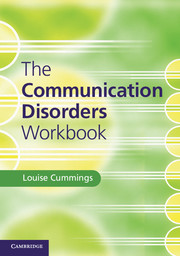Book contents
- Frontmatter
- Contents
- Preface
- Acknowledgements
- List of data analysis exercises
- Chapter 1 Introduction to communication disorders
- Chapter 2 Developmental speech disorders
- Chapter 3 Developmental language disorders
- Chapter 4 Communication disorders in mental illness
- Chapter 5 Acquired speech disorders
- Chapter 6 Acquired language disorders
- Chapter 7 Disorders of voice
- Chapter 8 Disorders of fluency
- Chapter 9 Hearing disorders
- Answers to questions and exercises
- Glossary
- References
- Index
- References
Chapter 4 - Communication disorders in mental illness
Published online by Cambridge University Press: 05 June 2014
- Frontmatter
- Contents
- Preface
- Acknowledgements
- List of data analysis exercises
- Chapter 1 Introduction to communication disorders
- Chapter 2 Developmental speech disorders
- Chapter 3 Developmental language disorders
- Chapter 4 Communication disorders in mental illness
- Chapter 5 Acquired speech disorders
- Chapter 6 Acquired language disorders
- Chapter 7 Disorders of voice
- Chapter 8 Disorders of fluency
- Chapter 9 Hearing disorders
- Answers to questions and exercises
- Glossary
- References
- Index
- References
Summary
Clients with a range of mental illnesses form an increasingly significant part of the caseload of speech and language therapists. Conditions such as schizophrenia have adverse implications for language and communication. Specific linguistic features include a reduction in the amount of spoken output (poverty of speech) and a reduction in the amount of content expressed through speech (poverty of content of speech). Clients with schizophrenia may also make bizarre and irrelevant contributions to a conversational exchange, interpret non-literal and figurative language in a literal way, and fail to observe linguistic politeness in their interactions with others. Alongside marked deficits in pragmatics and discourse, impairments in syntax and semantics are also commonly observed. For example, clients with schizophrenia produce syntactic gaps, e.g. ‘he was blamed for and I didn't think that was fair’ (Chaika and Alexander, 1986). Clients with bipolar disorder exhibit some of these same linguistic features (e.g. tangentiality). However, they can also display linguistic behaviours which are rarely seen in clients with schizophrenia (e.g. pressured speech).
There is increasing recognition among clinicians and educators of the significant language and communication problems which occur in children with emotional and behavioural disorders. These disorders include attention deficit hyperactivity disorder (ADHD), conduct disorder and selective mutism. The child with ADHD may interrupt others during conversation, blurt out answers before questions have been completed, display frequent topic shifts in conversation, and initiate conversation at inappropriate times. Alongside these pragmatic anomalies, deficits in expressive and receptive language skills have been frequently reported in children with emotional and behavioural disorders (see Cummings 2009, 2014a for discussion).
- Type
- Chapter
- Information
- The Communication Disorders Workbook , pp. 58 - 71Publisher: Cambridge University PressPrint publication year: 2014



